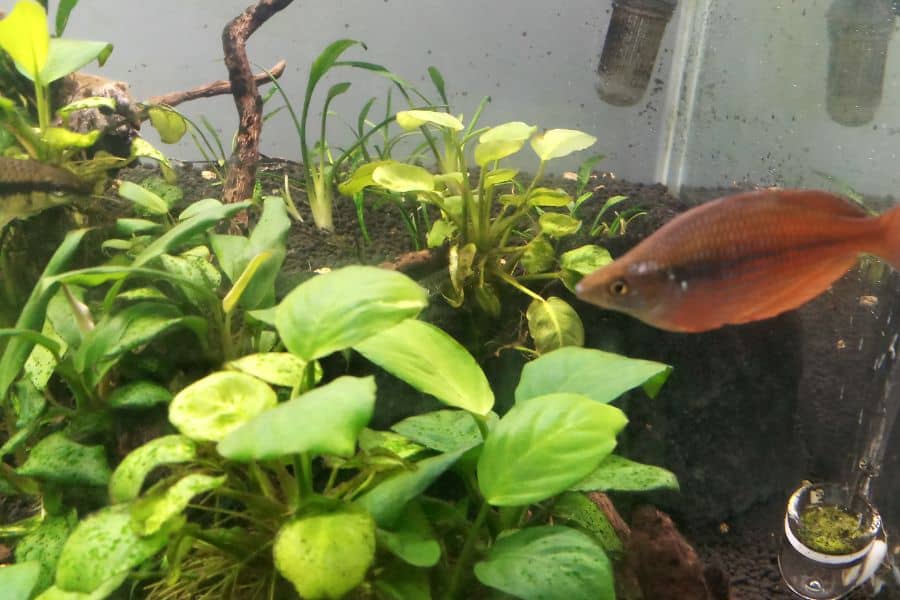Anubias is a great option for low-light fish tanks. This easy-to-grow plant typically tolerates lower light conditions than most aquarium plants. No special care is needed.
Many fishkeepers grow this plant because it can keep the water clean in their aquariums. Plus, it provides a living environment for many aquatic creatures.
The eaves of this plant don’t produce too much oxygen which can contribute to algae growth. Fish looking for an extra hiding spot appreciate its broad and large leaves.
All of this makes the Anubias plant an excellent addition to almost any fish tank. That’s why it is popular with both experienced aquarists and beginners.
If you want to add Anubias plants to your aquarium, you need to find out what conditions they need and how to care for them. Read on for more information on this gorgeous plant.
Things to Know When Growing Anubias in a Planted Aquarium
Anubias is a rather hardy plant that is easy to care for. As such, it’s a great addition to aquariums.
You can grow it without much effort even if you’re a beginner aquarist. There are a lot of good reasons to keep it in your fish tank, including:
- Multiple placements
- Nice deep green color
- It can keep your fish tank clean
- Low maintenance
- Easy to care
Nevertheless, there are a few things you should know before starting to grow Anubias. Here they are!
Maintenance & Conditions
Anubias is a plant that tolerates various water conditions, meaning it can be kept in just about any aquarium. Take a look at the table below.
| Minimum aquarium size | 5 gallons (19 liters) |
| Placement | Mid-background |
| Care | Easy |
| Temperature | From 72 to 82 °F |
| Light requirements | Low to moderate |
| Hardness | 60-160 ppm |
| pH | From 6.5 to 7.8 |
Anubias can withstand a variety of water conditions. This means it is highly likely to thrive in your fish tank with other plants and animals.
As a slow-growing species, Anubias needs low maintenance. After planting, it only involves trimming the plants from time to time.
One of the main reasons it’s so popular with fishkeepers is that Anubias can grow in different places. It is usually planted into the aquarium substrate. However, you can also tie Anubias plants to ornaments such as rocks or driftwood and they will survive.
On top of that, a couple of these plants can keep your aquarium clean. Just like other aquatic plants, Anubias needs nutrients for growth. By absorbing harmful by-products like nitrates, nitrites, and ammonia, these plants can keep the aquarium safe for your fish.
Planting: How to Plant Anubias
Setups that do not have substrate are a good choice for Anubias. Unlike most aquarium plants, it has the ability to absorb nutrients by means of its leaves.
Basically, you have two options when it comes to planting Anubias in fish tanks:
- Planting in the substrate, and
- Planting on ornaments
Planting in The Substrate
If you choose to plant Anubias in the substrate, make sure it is rich in nutrients to cause the plants to grow faster. It’s definitely the best choice.
Alternatively, you can use sand for planting. Anubias can even survive in gravel substrate with fine grains. However, don’t expect your plant to thrive as fast as it would in muddy nutrient-rich substrates.
Related: 13 Best Aquarium Plants for a Sandy Substrate
Planting on Ornaments
Another option is to plant your Anubias on ornaments like driftwood or rock. This is a quite simple process that doesn’t take a lot of time and effort.
Simply tie the rhizomes of your plants to porous rocks or driftwood to keep them in place. Use either a cotton string or a fishline. Glue can also work.
Thanks to strong roots, Anubias plants can easily attach to their surface. This process usually takes three or four weeks. Afterward, you will have difficulty separating them.
Not everyone wants to bother with planting and attaching the plants. Some people are not interested in buying rocks or wood just for this purpose. If you are one of those people, you should look for pre-attached plants that come on driftwood or another surface.
Propagation: How to Propagate Anubias
Propagation of Anubias plants involves the division of their rhizomes. Hence, the rhizome plays a crucial role in propagating Anubias.
If it’s split in half, each part of the rhizome will act as a separate plant. Each of them will continue to grow individually. So, how do you propagate Anubias plants?
Grab the fully grown plant and take it out of the aquarium. Then cut its rhizome with a sharp knife or scissors. Whatever you use, make sure it is sterile.
Be careful not to remove plenty of plant cuttings. That’s because plants with a lot of cuttings will have a tough time surviving when they are returned to the aquarium.
On each cutting, there should be at least 3 leaves. It allows them to keep photosynthesizing and growing on their own. After putting them back, the cuttings are going to produce more leaves as they’re growing.
The propagation of Anubias plants is explained here. Check it out!
Anubias Plant Care: How to Take Care of Your Plants
Anubis is a hardy and low-tech plant that doesn’t require high-intensity light to grow. Moreover, it can thrive in diverse water parameters and doesn’t have demanding substrate requirements.
While every plant appreciates some extras like fertilizers and carbon dioxide, they can grow without them. That makes Anubias an easy-to-care plant. Below are the ideal conditions and requirements.
- Water parameters: This freshwater plant tolerates an extensive range of water conditions. As for the water temperature, anything from 70F° to 82F° is considered ideal. The water hardness should be from 3 to 8 KH while the pH value needs to be from 6 to 8.
- Light requirements: Even though Anubias grows in various lighting conditions, it prefers low to medium light. It can also do well under high lighting. Nevertheless, avoid high light because the leaves will be more susceptible to the growth of algae.
- Fertilization requirements: Although nutrients are needed for the Anubias’ growth, it’s not necessary to give your plant additional fertilizers. It will grow by taking any nutrients in your fish tank. Yet, it won’t grow quickly and will not look vibrant.
- Substrate requirements: In addition to soil and sand, Anubias can be planted in gravel substrate too. However, if you want your plant to be lush and healthy, use a nutrient-rich substrate in our aquarium for the best results.
Now that you know what Anubias requires, you should also know how to maintain it after planting. Luckily, you won’t have to do much else.
Maintenance mostly comes down to pruning and removing dead leaves now and then. Anubias is a slow-growing plant, so new leaves appear every 4-6 weeks.
Besides, you will also need to propagate your Anubias plants. Maybe you do not want to harvest the seeds and wait for flowers.
As an alternative, you can propagate your plants by dividing the rhizomes as described above. That’s all, mate!
Top 5 Popular Types of Anubias
There are many different types of Anubias on the market to choose from. Anubias barteri is the most popular type that many aquarists grow in their fish tanks.
It features wide, dark green leaves. The size of the leaves varies between specific species. They can grow from 0.5 to 5.5 inches.
Keep in mind that all the species of Anubias grow slowly. A new leaf needs from 4 to 6 weeks to form completely.
Here are the 5 most popular types of Anubias:
- Anubias Nana Petite
- Anubias Barteri Round
- Anubias Nana Golden
- Anubias Barteri var. Glabra
- Anubias Nana Pinto
1. Anubias Nana Petite
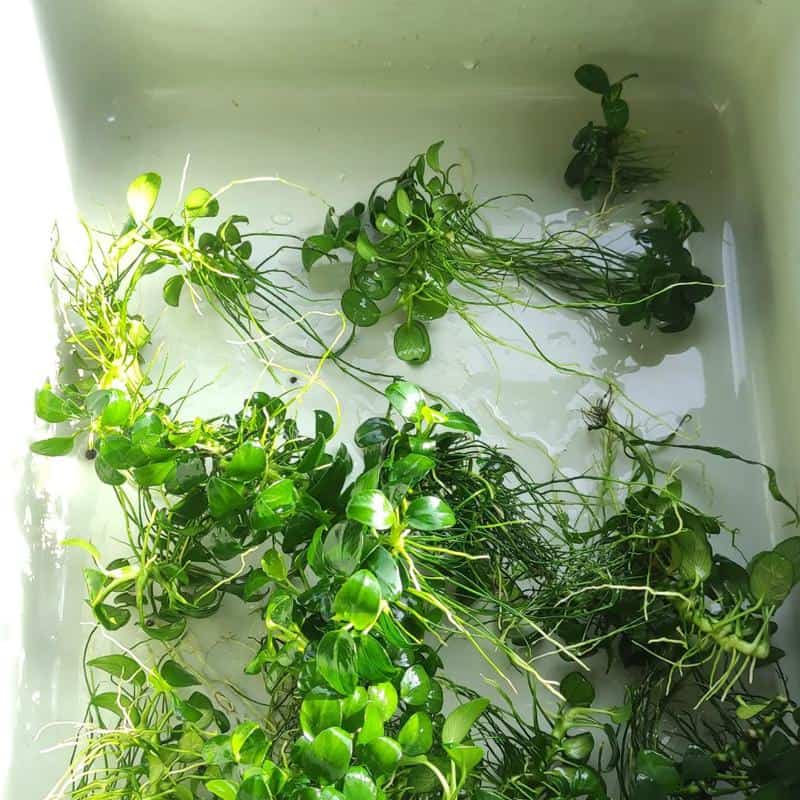
According to many aquarists, this is the most famous Anubias species. That’s why it is a traditional addition to many fish tanks. So, what makes it so popular?
Due to the small size, Anubias Nana Petite is suitable for nano fish tanks in particular. However, it can also be used in larger setups as a foreground placement.
This plant is notable for its captivating small leaves that are about 0.2 inches wide and 0.6 inches long. Dark green coloration makes it distinct from other aquarium plants.
Aquarists are the only ones who appreciate this plant. As it turned out, fish also like their leaves to hide behind them.
2. Anubias Barteri Round
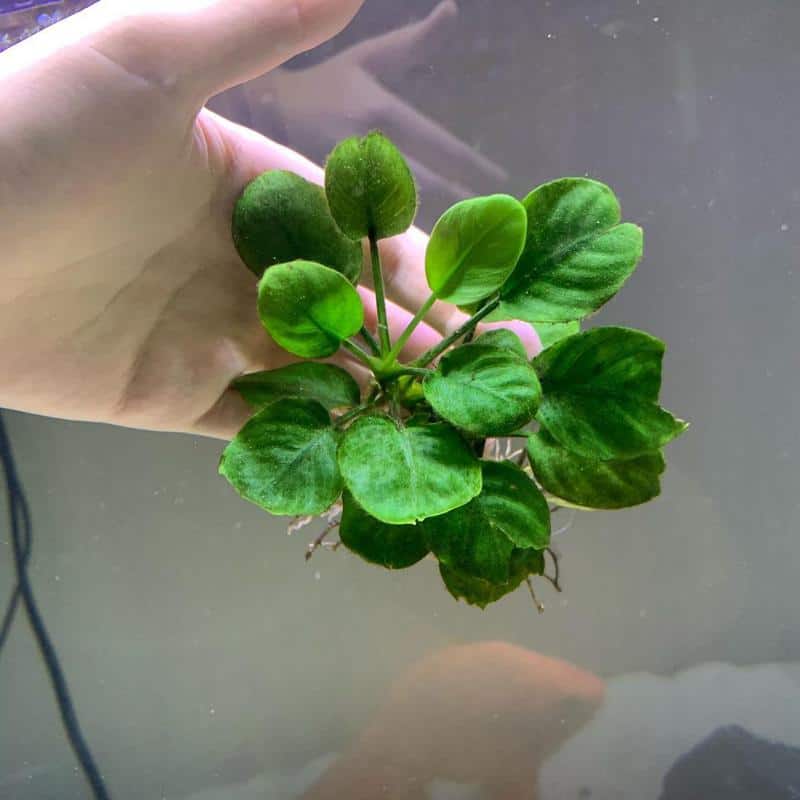
As the name suggests, this type of Barteri has more circular and round leaves. That makes it look unique. It is also known as Anubias Golden Coin.
The stems are a bit longer than the Anubias Nana species, which makes it a good fit for background or mid placement in aquariums. This plant is very easy to grow because it can withstand various water parameters.
You can attach the plants directly to rocks or driftwood in your tank, using glue or thread. Aside from aquariums, Golden Coin can also grow successfully in emersed or submerged terrariums.
Of course, it prefers nutrient-rich substrates. Make sure the rhizomes of the plants are located above the substrate. Otherwise, your plants may start to rot after propagation.
3. Anubias Nana Golden
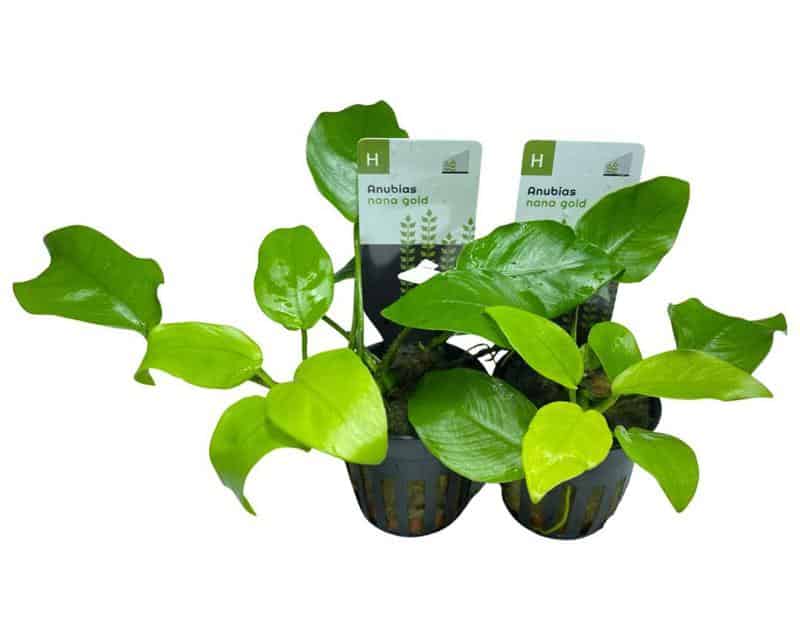
This variety is very similar to Nana Petite, but it is slightly larger. Compared to typical dark green Anubias leaves, the coloration of this kind of plant is yellow and light.
Sometimes the leaves of Anubias Nana Golden can reach five inches in length. To cultivate lush plants with big leaves, you need to provide them with adequate light and water conditions. Give them generous amounts of nutrients, too.
Anubias Nana Golden is an excellent addition to any freshwater aquarium. With a background or mid placement, it can add to the beauty of your fish tank.
4. Anubias Barteri var. Glabra
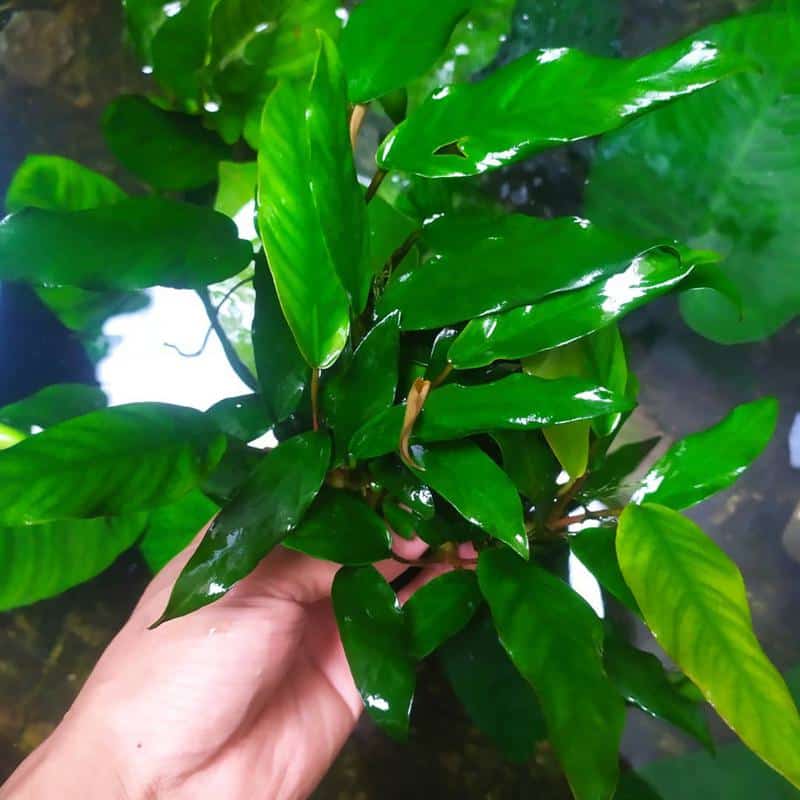
It is also called Anubias minima ‘Variegated’. What makes this type popular with aquarists is the lanceolate shape of leaves and white variegation. Note that it is an undemanding epiphyte.
With white-spotted narrow leaves, ‘Variegated’ looks striking when attached to rock or wood. This is particularly true when it’s placed in the midground of aquariums.
The leaves have a white spot pattern, which doesn’t always occur at the early stages of growth. This effect typically appears after some period of cultivation.
5. Anubias Nana Pinto
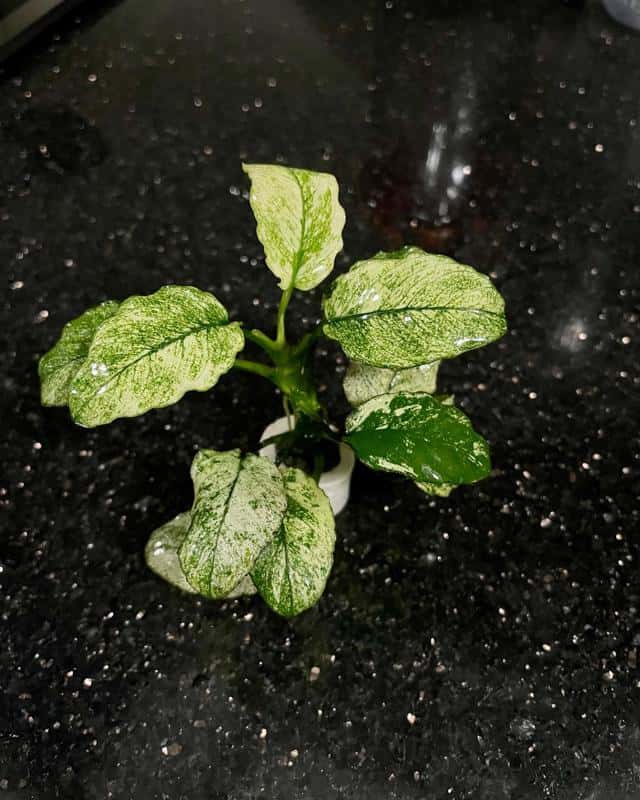
Produced by artificial selection, this attractive variety has some unique characteristics.
Nonetheless, it is underrated or not appreciated enough among fish keepers. That is because many of them are not aware of this type of plant and its advantages.
Anubias Nana Pinto boasts magnificent leaves with nice white-green patterns. Each leaf is distinctive, meaning there are no two identical leaves or plants.
For white and healthy variegation, high lighting conditions are necessary. Remember that it requires more light than other species. On the other hand, the growth rate is a bit slower.
Read More:
- Banana Plant for Aquarium Care Guide
- Best Carpet Plants for Aquarium
- Best Aquarium Plants with Flowers
- Lucky Bamboo in Aquarium
Final Thoughts
Anubias is an excellent aquarium plant that is easy to grow. It is capable of surviving nearly any water conditions and its requirements are very modest.
Therefore, if you’re a beginner, it is a safe bet that this hardy plant will be a good choice for you. You can either tie it to aquarium ornaments (like rocks or driftwood) or plant it in the substrate.
In any case, your Anubias plant will grow and thrive without any issues. Make sure that you choose a type that best suits your fish tank.
